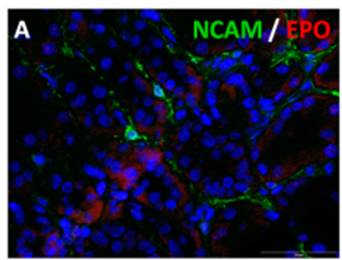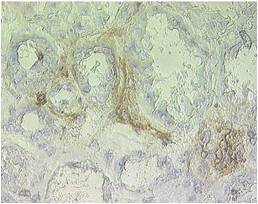Last week, Ximbio's Anti-NCAM clone ERIC-1 was published upon in a PLoS One paper from a collaboration between the University of Belgrade, Eberhard Karls University and Georg-August University. This publication, through the use of immunohistochemical and immunofluorescence studies, showed that an increased number of rare neural cell adhesion molecule (NCAM) positive cells are present in patients with interstitial renal fibrosis than in normal renal tissues.

Double immunofluorescent labelling of NCAM with erythropoietin (EPO). (Marković-Lipkovski et al. 2015. PLoS One. 10(9):e0137028.)
NCAM, also known as CD56, is a homophillic binding glycoprotein present on a variety of neural cells including neurons, glia, skeletal muscle and natural killer cells. NCAM has been implicated as having a role in cell-cell adhesion, neurite outgrowth, synatptic plasticity and learning and memory.
Clone ERIC-1 is a very versatile antibody with use in 7 different applications. The monoclonal was raised in Balb/c mice against a human retinoblastoma tissue membrane fraction.

Slide with rare NCAM cells within normal interstitium prior laser capture microdissection. (Marković-Lipkovski et al. 2015. PLoS One. 10(9):e0137028.)
Anti-NCAM was developed by John Kemshead during his time at the Imperial Cancer Research Fund. John left in 1994 to become a Senior Director at Nexell Therapeutics. He is currently based at Baxter Health within the Cellular Therapies division.
View the datasheet for more information and publications.
HAVE YOU REGISTERED?
Join the ever-growing global Ximbio community. Register and receive updates about new reagents, institutes and new features being added to the website.
